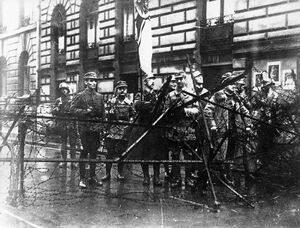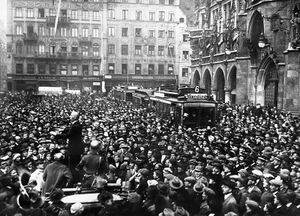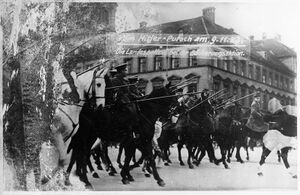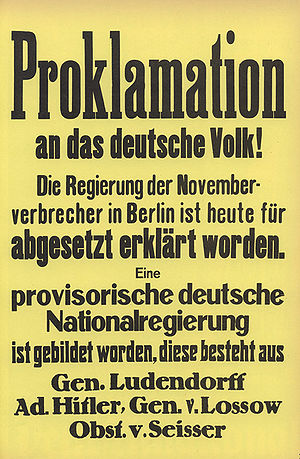
During the Weimar Republic's crisis year of 1923 (hyperinflation; Ruhr occupation and "Ruhr struggle" from January to September; communist unrest in Saxony and Thuringia), the party leader of the NSDAP, Adolf Hitler (1889-1945), wanted to depose the government in Berlin through an armed coup in Munich on 8/9 November and gain power himself in a national dictatorship. He had allied himself with right-wing radical forces for this purpose and tried to use right-wing conservative circles in the Bavarian government and administration. Since they soon distanced themselves and the Reichswehr did not play along, the project failed. The Bavarian State Police stopped the "Marsch auf die Feldherrnhalle” (March on the so called “Feldherrnhalle” [Field Marshal´s Hall] in Munich) by force (20 fatalities). Although Hitler was already released from prison after his trial on 20 December 1924, the attempted coup had significant long-term consequences both for him and for Bavaria.
Unstable Situation in the First Years of the Weimar Republic
Although the Republic was founded on a bloodless revolution in 1918/19 and was initially dominated by the democratic parties SPD (Sozialdemokratische Partei Deutschlands – Social Democratic Party of Germany), Zentrum (Deutsche Zentrumspartei – German Centre Party) and DDP (Deutsche Demokratische Partei – German Democratic Party), the new state did not come to rest until 1924: externally due to the problems and agitation surrounding the Versailles Treaty (cessions of territory, occupation, reparations), internally due to revolts by communists (Spartakus 1919, "Ruhrkampf" 1920, Central Germany 1921 and 1923) and right-wing radicals (Kapp-Lüttwitz-Putsch 1920, Buchrucker-Putsch 1923). In addition, there were serious economic problems caused by the demobilisation of troops and increasing inflation. The democratic parties in the Reich already lost the majority in 1920; the rise of the Republic´s critics and opponents - the DNVP (Deutschnationale Volkspartei - German National People's Party), the USPD (Unabhängige Sozialdemokratische Partei Deutschlands - Independent Social Democratic Party of Germany) and the KPD (Kommunistische Partei Deutschlands - Communist Party of Germany) - began.
Difficult Conditions in Bavaria
The situation was even more unstable in Bavaria, where at the end of April/beginning of May 1919 the radical left-wing Bavarian Soviet Republic had to be ended by the military of Prussia and Württemberg and by Freikorps'. The following governments (until 1920 SPD/BVP, then right-wing conservative civil servant governments) were rather weak. The main political problem, apart from the occupation of the Palatinate by French troops (danger of separatism), was Bavaria's relationship to the new German Reich. It was much more centralist than the Bismarck Empire, and Berlin also behaved ruthlessly, for example through the Erzberger Financial Reform, which affected the independence of the states. The independence of the postal service, railway and military in Bavaria (reserve rights in the Bismarck Empire) was also gone.
The fear of further nationalisation of Bavaria by the Reich and especially of negative influences from Berlin (socialist-led government in Prussia, the modern metropolis as moral "Sündenbabel" [city of sins]) provided a break-in point for anti-democratic efforts. This became particularly clear under the government of Gustav von Kahr (1862-1934, Minister-President 1920/21), who propagated a tight regiment in contrast to the "chaotic" north with the slogan "Ordnungszelle Bayern" ("Cell of Order Bavaria"), which also showed specifically xenophobic and anti-semitic tendencies (effort to expel eastern Jews from Bavaria under the pretext of usury since 1920, finally carried out in October 1923). Bavaria therefore also became an eldorado for right-wing radicals leaving Prussia (e.g. the famous World War general Erich Ludendorff [1865-1937]; the head of the secret Organisation Consul, Hermann Ehrhardt [1881-1971]; both in Upper Bavaria since 1920).
Hitler's Rise and Alliance Policy
The state of the Reich, and Bavaria in particular, was favourable for the rise of Adolf Hitler (1889-1945), who had been the unconditional leader of the NSDAP (Nationalsozialistische Deutsche Arbeiterpartei - National Socialist German Workers' Party) in Munich since 1921. The domestic political climate was heated, the revolutionary, nationalist and militarist spirit (generation of front fighters) was omnipresent due to the residents' defences. After their ban in 1921, all kinds of combat units dominated the field; monarchist traditional units and the Wittelsbach Crown Prince Rupprecht (1869-1955) also largely rejected the Republic.
Many people initially saw the NSDAP as part of these tendencies. But Hitler, who was aiming for power in the Reich and sole leadership, was not satisfied with the considerable success of his party's rallies and the influx into his organisations. However, he found alliance partners less in conservative associations such as "Bayern und Reich" than in radical-nationalist and paramilitary Freikorps groups, such as the "Reichsflagge", the "Bund Oberland" and others. The SA (Sturmabteilung - Storm Detachment) he founded in 1921 was trained militarily by Captain Ernst Röhm (1887-1934) and by Hermann Göring (1893-1946) since 1922. It was particularly important that Hitler was widely supported in the intellectual public (e.g. publisher Hugo Bruckmann [1863-1941]; university lecturer Karl Alexander von Müller [1882-1964]) as well as the Bavarian government and administration, such as Franz Gürtner (1881-1941, Bavarian Minister of Justice 1922-1932), Ernst Pöhner (1870-1925, Police President of Munich 1919-1921) and Wilhelm Frick (1877-1946, Head of Political Police 1919-1923).
The Path to the Putsch
There were rumours that Hitler was going to carry out a coup as early as 1922. Several stages led to the final decision: a German Day in Coburg on 14/15 October; the 1st NSDAP National Congress on 27/29 January 1923 in Munich, which Hitler had wrested from the government with the promise not to carry out a coup; then a highly explosive and partly armed mass march against the trade unions on 1 May 1923 at Munich's Oberwiesenfeld; finally the German Day in Nuremberg on 1/2 September 1923, when Hitler joined Ludendorff and got hold of the political leadership of the "Deutscher Kampfbund" (SA, "Bund Oberland" and "Reichskriegsflagge", a radical separation group from the "Reichsflagge"). Following the example of Benito Mussolini (1883-1945) and Mustafa Kemal Atatürk (1881-1938) (march on Rome; fight against the Greeks), his goal in 1922 was to march from Bavaria, the supposed last "German bastion", to Berlin and to establish a national dictatorship against Marxists and Jews. The prerequisite for this was the willingness of politicians and the military to join or at least tolerate this approach.
The opportunity arose when the Bavarian government declared a state of emergency when the "Ruhr Struggle" was broken off by the Reich government on 26 September 1923 and proclaimed former Minister-President von Kahr General State Commissioner with de facto dictatorial authority. This immediately drove the conflict with Berlin to a climax. He repealed the enforcement decree of the Republikschutzgesetz (Republic Protection Act, 1922) for Bavaria, aligned himself with the head of the State Police Hans von Seißer (1874-1973) and subordinated Otto von Lossow (1868-1938) to him, the Commander of the Reichswehr in Bavaria, who had been deposed by Berlin, and thus took the Reichswehr to task for Bavaria; it was supposed to secure the border against the SPD, USPD and KPD led Thuringia. Kahr sought to gather the national associations around himself, but not for a coup against Berlin but as a support basis for the installation of a Reich government in Berlin that would be inundated with emergency powers. Hitler, who wanted to march from Munich, felt that the leadership might slip away from him, and decided to strike out and involve the "triumvirate" Kahr-Lossow-Seißer; the plans were developed with leaders of the Oberland Bund, with Baltic free corps fighter Max Erwin von Scheubner-Richter (1884-1923) and Franconian court counsel Theodor von der Pfordten (1873-1923) on 6 November, both of whom died on 9 November.
Not to be underestimated for the mood at the time, apart from the dispute with Berlin, apart from the inflation that was reaching its peak and apart from the threatening hunger crisis, was the impression of the communist danger. At the beginning of October, the Politburo in Moscow and the Executive Committee of the Third International under Grigory Zinoviev (1883-1936) had decided on an uprising of the KPD in Germany ("German October"), which was to take place through the leftist governments in Saxony and Thuringia and the "Proletarian Hundreds" permitted there, and which was to achieve a new revolution in Germany on 9 November (Weber, Hitler). In Bavaria, too, the KPD prepared intensively both politically and militarily for the uprising, which was to be achieved first and foremost through a united front with the SPD in the struggle against the right (Zehetmair). Even though the Reich had been able to intervene in the two states since mid-October and thus eliminate the current danger (the southern Bavarian KPD leadership was arrested by the Bavarian police on 20 October), and the uprising in Hamburg on 23/25 October was also brutally crushed, these events nevertheless offered excellent arguments for the right-wing radicals.
The Events
There was an invitation to a meeting with Kahr at the Bürgerbräu beer hall near Gasteig in Munich on 8 November 1923, which was attended not only by Lossow and Seißer but also by the head of government Eugen von Knilling (1865-1927, Minister-President 1922-1924), several ministers and many conservative dignitaries. Hitler, who originally wanted to strike on 11 November, now hoped to win the assembly over to his side through a coup; he had called up the Kampfbund's armed units and occupied the surrounding area for this purpose. During Kahr's speech, Hitler infiltrated the assembly and gained silence with one single shot. Then he forced Kahr, Lossow and Seißer into an adjoining room and, with the threat of a pistol and persuasion, then also with the help of the World War general Ludendorff, who had been called in, and Chief of Police Pöhner, obtained the consent of all three to participate in the action and in a new Reich and state government:
- Adolf Hitler: Political Director,
- Erich Ludendorff: National Army,
- Otto von Lossow: Reich's Minister of Defence,
- Hans von Seißer: Minister of Police,
- Gustav von Kahr: Governor of the Monarchy in Bavaria,
- Ernst Pöhner: Bavarian Minister President.
-
Barricades at the Bavarian War Ministry in Munich, Schönfeldstraße. (Bayerische Staatsbibliothek - Bavarian State Library, Bildarchiv hoff-6604)
-
View of Munich's Marienplatz; standing as speaker: Julius Streicher. (Bayerische Staatsbibliothek - Bavarian State Library, Bildarchiv hoff-6610)
-
Mounted departments of the Bavarian State Police at Odeonsplatz in Munich. (Bayerische Staatsbibliothek - Bavarian State Library, Bildarchiv hoff-6608)
The ministers present were arrested and taken to the villa of the publisher Julius Friedrich Lehmann (1864-1935) on the outskirts of the city, and the headquarters were opened in the Bürgerbräu. Munich then immediately experienced a foretaste of the later Nazi terror, such as the devastation of the editorial office at the SPD newspaper Münchener Post or anti-Semitic attacks. These took place in the context of hostage-taking, which was guided by very simple anti-Jewish clichés, rather than directed at concrete persons, who were attacked and arrested more by chance; the Stoßtrupp Hitler (Hitler's bodyguard) and a detachment of the Bund Oberland were particularly active and proceeded in the vilest manner.
It quickly became apparent that the coup was poorly prepared and doomed to failure, probably also due to striking earlier than planned. The negotiation in the adjoining room with the triumvirate was already very laborious and lasted well over half an hour, which brought unrest. Only the former War Ministry (now Wehrkreiskommando VII) on Ludwigstraße (no. 24; today no. 14 Bayerisches Hauptstaatsarchiv) could be occupied by the Putschists, subsequently the Infantry School situated by the Marsfeld, but there were problems with the barracks. When Hitler hurried there, Kahr, Lossow and Seißer were allowed by to leave the Bürgerbräu and go to their offices, apparently regarding their initially forced willingness to cooperate as a voluntary word of honour. Inspite of the gained distance, it still took until after midnight (2:55 A.M.) for Kahr, Lossow and Seißer, now in the Infantry barracks, to revoke the action, announce their participation in the coup as violently extorted and to take the side of their authorities, who had worked resolutely against the coup. And finally, Minister Franz Matt (1860-1929, 1920-1926 Minister of Education and Cultural Affairs), together with three other ministers who had not been at the Bürgerbräu, proclaimed the continued existence of the Bavarian government and briefly went to Regensburg to get out of the way. The undertaking had therefore already failed that night; even the enlistment and partial influx of Hitler supporters from some Bavarian cities (from Nuremberg Julius Streicher [1885-1946]), even from Jena in Thuringia, did not change anything.
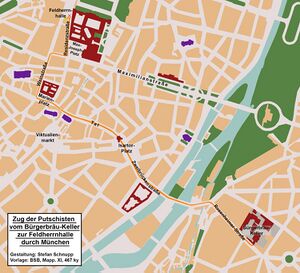
On Ludendorff's suggestion, it was decided to turn the tide and break Roehm free in the morning of 9 November. On the way from the Bürgerbräu via Marienplatz to Ludwigstraße, the approximately 2,000 partly armed rebels were stopped in front of Odeonsplatz by the Bavarian State Police, who fired their own shots after having been shot at (by whom, remained unclear): 15 fighters of the Kampfbund, 1 innocent civilian and 4 policemen died. The march scattered and the hurt Hitler was taken by car to Uffing am Staffelsee to the villa of Ernst Hanfstaengl (1887-1975) to flee to Austria from there; but he was arrested on 11 November. Uninjured Ludendorff was captured. Hitler was then taken to prison in Landsberg am Lech, where he was held in protective custody until 14 November 1923 and then in pre-trial custody until 21 February 1924. After the trial in Munich (26 February - 1 April 1924) he was in Landsberg again, now in "Festungshaft" (honourable "fortress confinement"), from which he was released on parole on 20 December 1924.
The search for the causes of failure, specifically for the reasons for Kahr's behaviour, already began at that time; it was asserted many times, particularly by right-wing radicals, that interventions by Crown Prince Rupprecht and Munich's Cardinal Michael von Faulhaber (1869-1952, Archbishop of Munich and Freising since 1917) were to blame, but this was not the case. A collection of sources brought forth in 2023 by Matthias Bischel allows for the reasoning that Kahr was an opponent of Hitler's action from the beginning, but that he acted very cautiously at the scene of the crime itself and then also for some time afterwards, above all in order to gain freedom of action and to ensure the success of the intervention against the putschists.
Immediate and Long-Term Consequences
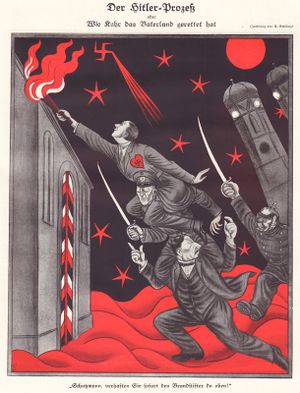
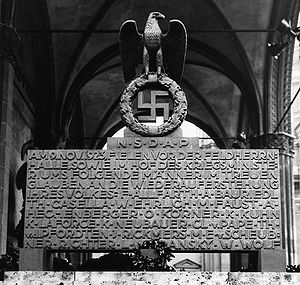
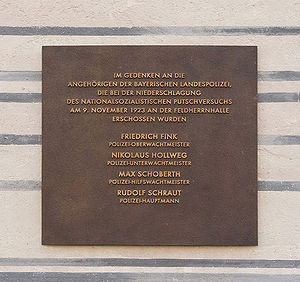
The immediate consequence of the attempted coup was a serious domestic political crisis in Bavaria, with the Putschists initially enjoying strong sympathies. As a result the "Völkische Block", founded after the immediate ban of the NSDAP, received 17% of the votes in the 1924 state elections (34% in the city of Munich). This corresponded to the shameful process and outcome of the Hitler trial. But the scene soon changed. Since Kahr's resignation as General State Commissioner on 24 February 1924 and the inauguration of Heinrich Held (1868-1938) as Minister-President in June 1924, the political leadership in Bavaria increasingly distanced itself from Hitler and soon became his fiercest opponent. This corresponded to an ever clearer ideological demarcation of the conservatives from National Socialism.
Hitler, for his part, changed tactics on the basis of his experiences in 1923; he now pursued the assumption of power in a formally legal way. His agitation also shifted more to non-Bavarian areas after the re-establishment of the NSDAP in 1925, from where he finally came to rule, although the party headquarters remained in Munich.
After 1933, the Nazi regime stylised the putsch into a cult event. Hitler awarded a "9 November Decoration of Honour" (Blood Order; by the end of the war about 4,000 bearers), a flag soaked with the blood of rebels became the main relic of the party as "blood flag" as early as 1926, writers spread the desired view of the events (e.g. Karl Richard Ganzer [1909-1943]). Large celebrations took place at the Feldherrnhalle and Königsplatz (temple of honour with the coffins of the Nazi dead) since 1933; the annual repetition of the march, with Streicher at the front, became a fundamental tradition. However, the celebrations were severely restricted since 1939 and dwindled to speeches and the laying of wreaths by regional party-leaders (Hitler still came to the Bürgerbräu until 1943). After the end of the war the dead were removed, the temples of honour were demolished in January 1947.
The Historiography
Both the determination of events and their interpretation must start from the large edition of the Hitler trial (Gruchmann), where the indictments are of special value; the volume's introduction is also important. Deuerlein's edition is relevant for the Bavarian scene, as are the extensive documents from the estate and the personal circle of Kahr (undiscovered until 2023); they allow for a precise reconstruction of the events and especially Kahr's conduct by the hour (Bischel, 30*-48*, 57*-60*). Wilhelm Hoegner's (1887-1980, SPD, Member of the Landtag [Bavarian Parliament] 1924-1930, Bavarian Minister-President 1946 and 1954-1957) compilation (1928) of materials of the committee instituted by the Landtag in 1927 to investigate Hitler's putsch is important as a contemporary manuscript. Unprinted archival materials (Bischel, 16* ff., Kellerhoff, 307 ff.) are now more easily accessable due to digitalisation.
Profound historical studies have existed since the 1970s, for example the one by Harold J. Gordon (1919-1980). They were substantially expanded upon through works in the context of the commemorative year 2023, in parts regarding the actual coup (see Niess); first and foremost, however, relating to it's circumstances, meaning the "crisis year" 1923, for which Longerich and Jones have to be mentioned, among others. Here, the documentation pertaining to Kahr's conduct (Bischel) is especially important for Bavaria; a series of lectures was held by the state archives ("Demokratie im Abwehrmodus. Bayern im Krisenjahr 1923"), which will be published at the end of 2024 (Archivalische Zeitschrift, Bd. 100). Gritschneder has pointed out many interesting and important aspects on the basis of the court files; his judgements are, of course, often very decided. All relevant biographies of Hitler deal with the event, often with further insights (e.g. Ullrich; Longerich). Many popular accounts have also appeared, especially in the English-speaking area (e.g. in Jeffrey Gaab, Munich. Hofbräuhaus & History - Beer, Culture & Politics, New York 2008) or in France (e.g. Chauvet Didier, Hitler et le putsch de la brasserie, Paris 2012); they are useful in individual cases, but usually produce few new facts. A narrative non-fiction account by King is very noteworthy due to contemporary testimonies and the multitude of foreign press products. For its public reception one must also look at televised programmes, like "Hitler vor Gericht" (Hitler before the Court, 2009) by the Austrian director Bernd Fischerauer (1943-2017), then BR-Alpha, or "Hitlerputsch 1923: Das Tagebuch der Paula Schlier" (Beer Hall Putsch 1923: The Diary of Paula Schlier, ARD 2023), which - amongst other sources - uses the records of an (opposed) young secretary at the Völkische Beobachter. For a deeper understanding it is crucial to put the events into a broader context; one must not just look at Munich: In particular, the problem of the fights in the Palatinate which ran parallel to the coup, the conditions in the Reich and the interests of European powers, especially France, must each be taken into account.
References
- John Dornberg, Hitlers Marsch zur Feldherrnhalle. München, 8. und 9. November 1923, München 2. Auflage 1998.
- Karl Richard Ganzer, Der 9. November 1923. Tag der ersten Entscheidung, München 1936 [NS-Sicht].
- Martin H. Geyer, Verkehrte Welt. Revolution, Inflation und Moderne, München 1914-1924, Göttingen 1998.
- Harold J. Gordon, Hitlerputsch 1923. Machtkampf in Bayern 1923-1924, Frankfurt am Main 1971.
- Otto Gritschneder, Bewährungsfrist für den Terroristen Adolf H. Der Hitler-Putsch und die bayerische Justiz, München 1990.
- Hans Hinterberger, Unpolitische Politiker? Die bayerischen „Beamtenministerpräsidenten“ 1920-1924 und ihre Mitverantwortung am Hitlerputsch, Regensburg 2016.
- Jürgen John, Jenaer Studenten in den bayerischen Putschvorbereitungen 1923, in: Zeitschrift für Geschichtswissenschaft 32 (1984) 313-331.
- David King, The Trial of Adolf Hitler. The Beer Hall Putsch and the Rise of Nazi Germany, New York 2017.
- David Clay Large, Hitlers München. Aufstieg und Fall der Hauptstadt der Bewegung (1998), erweiterte Neuauflage München 2018.
- Peter Longerich, Hitler. Biographie, München 2015.
- Horst Möller, München: Der Marsch auf die Feldherrnhalle 1923, in: Alois Schmid/Katharina Weigand (Hg.), Schauplätze der Geschichte in Bayern, München 2003, 369-387.
- Hans Mommsen, Adolf Hitler und der 9. November 1923, in: Johannes Willms (Hg.), Der 9. November. Fünf Essays zur deutschen Geschichte, München 2. Auflage 1995, 33-48.
- Lars Pappert, Der Hitlerputsch und seine Mythologisierung im Dritten Reich, Neuried 2001.
- Klaus D. Patzwall, Das Ehrenzeichen vom 9. November 1923 (Blutorden), Norderstedt 2. Auflage [1986].
- Kai Uwe Tapken, Die Reichswehr in Bayern von 1919 bis 1924, Hamburg 2002.
- Dirk Walter, Antisemitische Kriminalität und Gewalt. Judenfeindschaft in der Weimarer Republik, Bonn 1999.
- Volker Ullrich, Adolf Hitler. Biographie. Bd. 1: Die Jahre des Aufstiegs 1889-1939, Frankfurt 2013.
- Thomas Weber, Wie Adolf Hitler zum Nazi wurde. Vom unpolitischen Soldaten zum Autor von „Mein Kampf“, Berlin 2016.
- Sebastian Zehetmair, Im Hinterland der Gegenrevolution. Die kommunistische Bewegung in der „Ordnungszelle Bayern“ 1919 bis 1923, Düsseldorf 2022.
- Peter Zinke, Der „Hitlerputsch“ und Nürnberg, in: Nurinst 2 (2004), 111-128.
- Wolfgang Zorn, Bayerns Geschichte im 20. Jahrhundert, München 1986.
Sources
- Ernst Deuerlein (Hg.), Der Hitler-Putsch. Bayerische Dokumente zum 8./9. November 1923, Stuttgart 1962.
- Peter Fleischmann, Hitler als Häftling in Landsberg am Lech 1923/24. Der Gefangenen-Personalakt Hitler nebst weiteren Quellen aus der Schutzhaft-, Untersuchungshaft- und Festungshaftanstalt Landsberg am Lech, Neustadt an der Aisch 2. Auflage 2018.
- Eberhard Jäckel/Axel Kuhn (Hg.), Hitler. Sämtliche Aufzeichnungen 1905-1924, Stuttgart 1980.
- Lothar Gruchmann u. a. (Hg.), Der Hitler-Prozess 1924 (Hitler. Reden, Schriften, Anordnungen Februar 1925 bis Januar 1933. Ergänzungsband). 4 Bände, München 1997-1999.
- Wilhelm Hoegner (Hg.), Hitler und Kahr. Die bayerischen Napoleonsgrößen von 1923. Ein im Untersuchungsausschuß des Bayerischen Landtags aufgedeckter Justizskandal, hg. vom Landesausschuß der S.P.D. in Bayern, 2 Teile, München 1928.
- Hellmut Schöner (Hg.), Hitler-Putsch im Spiegel der Presse. Berichte bayerischer, norddeutscher und ausländischer Zeitungen über die Vorgänge im November 1923 in Originalreproduktionen, München 1974.
- Hermann Wilhelm (Hg.), Die vergessenen Opfer. Dokumente, Polizeiakten und Augenzeugenberichte zum Terror in den Tagen des Hitlerputsches am 8. und 9. November 1923, unter Hervorhebung der Haidhauser Ereignisse und Akteure, München 2004.
Further research
External links
Related articles
Munich Putsch
Cite
Walter Ziegler, Beer Hall Putsch (Hitlerputsch), 8-9 November 1923, published 11 May 2006, english version published 21 February 2020; in: Historisches Lexikon Bayerns, URL: <https://www.historisches-lexikon-bayerns.de/Lexikon/EN:Beer_Hall_Putsch_(Hitlerputsch),_8-9_November_1923> (20.12.2025)

